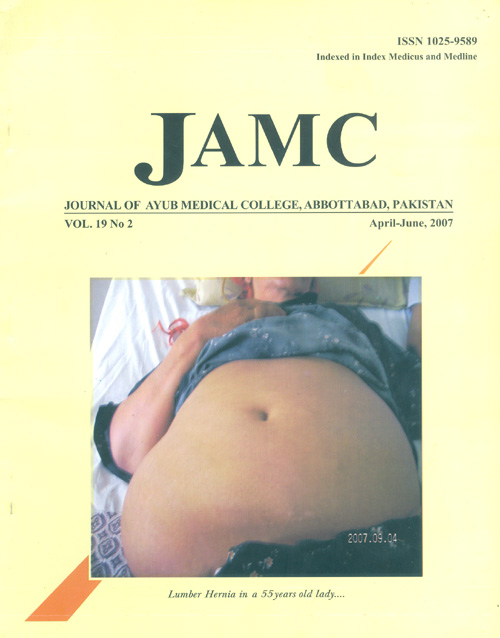COST EFFECTIVENESS OF SCREENING OF ALL NEWLY RECRUITED EMPLOYEES FOR DIABETES AT A TERTIARY CARE HOSPITAL
Abstract
Background: Diabetes Mellitus is a disease which remains asymptomatic for long duration oftime and usually diagnosed either when gets complicated or by routine or opportunistic screening.
The practice of universal screening is not recommended, particularly in constraint resources.
However, we embarked with a study to assess the yield of recommended screening f or Type 2
diabetes in all the newly recruited employees at a tertiary care hospital in Karachi. Methods: All
the information required for this study was collected from medical records of all newly recruited
employees of nursing services department of a tertiary care hospital of Karachi, Pakistan, over a
period of 5 months (August 2004 to December 2004). Out of 360 subjects , 326, whose
information was found to be complete, were included for final analysis. Results: Mean age of the
study subjects was 25.3 ± 4.7 years and their mean casual plasma glucose level was 99.1 ± 16.3
mg/dl. 315 (96.6%) study subjects had casual plasma glucose level of 139 mg/dl or less. Only 10
(3.1%) study subjects had casual plasma glucose levels between 140 to 199 mg/dl. Just one
employee, 41 years old, was found to have casual plasma glucose level of 213 mg/dl. Conclusion:
In this study, screening of all individuals for diabetes had a very low yield. Recommendation of
universal screening for diabetes does not represent a good use of resources and perhaps not costeffective. However, periodic screening of high risk individuals should be warranted.
Key words: Diabetes; Screening; Population; Cost-effectiveness
References
American Diabetes Association. Screening for type 2
diabetes. Diabetes Care 2004; 27: S11-S14
U.S. Preventive Services Task Force. Guide to clinical
preventive services: report of the U.S. Preventive Services
Task Force. 2nd ed. Baltimore: Williams & Wilkins; 1996.
U.S. Preventive Services Task Force. Screening for Type 2
Diabetes Mellitus in Adults: Recommendations and
Rationale: Annals of Internal Medicine 2003;138(3): 212-
American Diabetes Association. Standards of medical care in
diabetes-2006. Diabetes Care 2006; 29: S4-S36.
Goyder EC, Irwing LM. Screening for type 2 diabetes
mellitus: a decision analytic approach. Diabet Med 2000;17:
-477.
Ko Gt, Chan JC, Tsang LW, Yeung VT, Chow CC, Cockram
CS. Outcomes of screening for diabetes in high-risk Hong
Kong Chinese subjects. Diabetes Care 2000;23:1290-1294.
Lee DS, Reminton P, Madagame J, Blustein J. A cost
analysis of community screening for diabetes in the central
Wisconsin Medicare population (results from the MetaStar
pilot project in Wausau). WMJ 2000;99:39-43.
Lindahl B, Weinehall L, Asplund K, Hallmans G. Screening
for impaired glucose tolerance. Results from a populationbased study in 21, 057 individuals. Diabetes Care
;22:1988-1992.
World Health Organization. Diabetes Mellitus. Fact sheet
No.138. Available at:
http://www.who.int/mediacentre/factsheets/fs138/en/
Accessed on: 4/4/2006.
Lawrence JM, Bennett P, Young A, Robinson AM.
Screening f or diabetes in general practice: cross sectional
population study. BMJ 2001; 323: 548-551.
Staged Diabetes Management. Detection & Treatment Quick
Guide. 2 nd ed. International Diabetes Center. Institute for
Research and Education 3800 Park Nicollet Boulevard; 1999.
p.1-2.
American College of Obstetricians and Gynecologists.
Guidelines for Women's Health Care. 2 nd ed. Washington,
DC: American Coll of Obstetricians and Gynecologists;
p 210-3.
Lawrence J, Robinson A. Screening for diabetes in general
practice. Prev Cardiol 2003; 6: 78-84.
World Health Organization. Screening for Type 2 Diabetes.
Report of a World Health Organization and International
Diabetes Federation meeting. World Health Organization.
Department of Non-communicable Disease Management.
Geneva, Switzerland; 2003.
Downloads
How to Cite
Issue
Section
License
Journal of Ayub Medical College, Abbottabad is an OPEN ACCESS JOURNAL which means that all content is FREELY available without charge to all users whether registered with the journal or not. The work published by J Ayub Med Coll Abbottabad is licensed and distributed under the creative commons License CC BY ND Attribution-NoDerivs. Material printed in this journal is OPEN to access, and are FREE for use in academic and research work with proper citation. J Ayub Med Coll Abbottabad accepts only original material for publication with the understanding that except for abstracts, no part of the data has been published or will be submitted for publication elsewhere before appearing in J Ayub Med Coll Abbottabad. The Editorial Board of J Ayub Med Coll Abbottabad makes every effort to ensure the accuracy and authenticity of material printed in J Ayub Med Coll Abbottabad. However, conclusions and statements expressed are views of the authors and do not reflect the opinion/policy of J Ayub Med Coll Abbottabad or the Editorial Board.
USERS are allowed to read, download, copy, distribute, print, search, or link to the full texts of the articles, or use them for any other lawful purpose, without asking prior permission from the publisher or the author. This is in accordance with the BOAI definition of open access.
AUTHORS retain the rights of free downloading/unlimited e-print of full text and sharing/disseminating the article without any restriction, by any means including twitter, scholarly collaboration networks such as ResearchGate, Academia.eu, and social media sites such as Twitter, LinkedIn, Google Scholar and any other professional or academic networking site.










